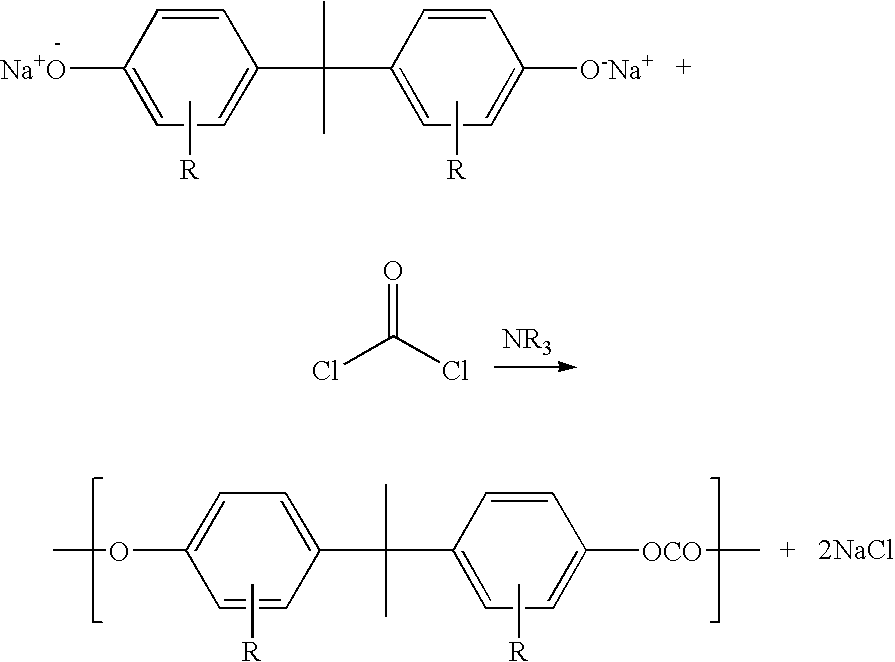Process for the preparation of polycarbonate
a technology of polycarbonate and polycarbonate, which is applied in the field of polycarbonate preparation, can solve the problems of unfavorable environmental protection, unfavorable environmental protection, and unfavorable environmental protection, and achieves the effects of reducing the number of pollutants in the wastewater, reducing the number of pollutants, and reducing the quality of wastewater obtained
- Summary
- Abstract
- Description
- Claims
- Application Information
AI Technical Summary
Benefits of technology
Problems solved by technology
Method used
Image
Examples
example 1
Addition of Sodium Chloride-Containing Reaction Wastewater to the Sodium Chloride Electrolysis-Feed of a 10% Strength by Weight Sodium Chloride Solution from the polycarbonate Preparation
[0154]24 000 kg / h with an alkaline bisphenol A solution which contains 15% by weight of bisphenol A (BPA) and 2.1 mol of sodium hydroxide solution per mole of BPA were metered before the pump via a T-piece, and 1848 kg / h of phosgene, dissolved in 20 400 kg / h of solvent which consisted of 50% by weight of methylene chloride and 50% by weight of monochlorobenzene, were metered via a further T-piece, into a pumped circulation reactor.
[0155]In order to maintain the alkalinity, 360 kg / h of 32% strength sodium hydroxide solution were metered in and the reaction mixture was passed back to the pump via a heat exchanger and an unstirred dwell container, the abovementioned material streams being metered in.
[0156]The amount circulated by pumping was determined as 260 m3 / h by means of a flow rate measurement.
[0...
example 2
Addition of Sodium Chloride-Containing Reaction Wastewater to the Sodium Chloride Electrolysis of Gas Diffusion Electrode—Addition of a 10% Strength by Weight Sodium Chloride Solution (Reaction Wastewater) from the polecarbonate Preparation
[0170]The wastewater corresponded in quality to that according to Example 1. Since no hydrogen is required for the preparation of polycarbonate, it was possible to dispense with the formation of hydrogen in the electrolysis. The electrolysis was therefore operated with gas diffusion electrodes. The current density was 4 kA / m2, outflow temperature on the cathode side 88° C. and outflow temperature on the anode side 89° C. An electrolysis cell having a standard anode coating from DENORA, Germany, was used. Nafion® 982 WX ion exchanger membrane from DuPont was used. The electrolysis voltage was 2.11 V. 0.65 kg / h of a 25% strength by weight NaCl solution was fed into the anode chamber, and the solution taken off from the anode chamber contained 18% by...
example 3
Addition of Sodium Chloride-Containing Reaction Wastewater to the Sodium Chloride Electrolysis with Gas Diffusion Electrode—Addition of a 10% Strength by Weight Sodium Chloride Solution (Reaction Wastewater) from the polycarbonate Preparation
[0173]The wastewater corresponded in quality to that according to Example 1. Since no hydrogen is required for the preparation of polycarbonate, it was possible to dispense with the formation of hydrogen in the electrolysis. The electrolysis was therefore operated with gas diffusion electrodes. The current density was 4 kA / m2, outflow temperature on the cathode side 88° C. and outflow temperature on the anode side 89° C. An electrolysis cell having a standard anode coating from DENORA, Germany, was used. Nafion® 2030 ion exchanger membrane from DuPont was used.
[0174]The electrolysis voltage was 1.96 V. 0.65 kg / h of NaCl solution was fed into the anode chamber, the sodium chloride concentration of the NaCl solution fed to the anode chamber was 25...
PUM
| Property | Measurement | Unit |
|---|---|---|
| Temperature | aaaaa | aaaaa |
| Temperature | aaaaa | aaaaa |
| Percent by mass | aaaaa | aaaaa |
Abstract
Description
Claims
Application Information
 Login to View More
Login to View More - R&D
- Intellectual Property
- Life Sciences
- Materials
- Tech Scout
- Unparalleled Data Quality
- Higher Quality Content
- 60% Fewer Hallucinations
Browse by: Latest US Patents, China's latest patents, Technical Efficacy Thesaurus, Application Domain, Technology Topic, Popular Technical Reports.
© 2025 PatSnap. All rights reserved.Legal|Privacy policy|Modern Slavery Act Transparency Statement|Sitemap|About US| Contact US: help@patsnap.com

